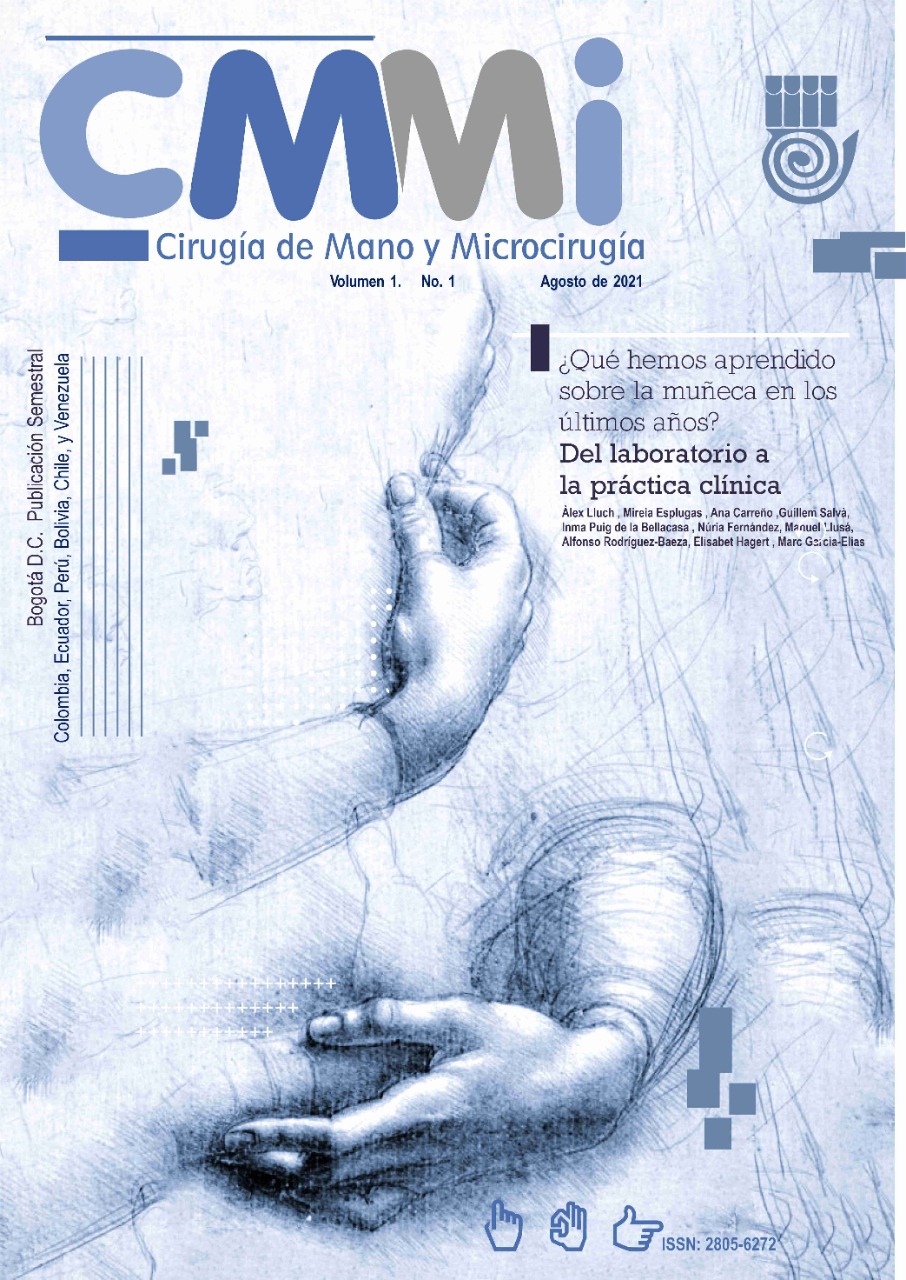Open osteochondral fracture of the distal phalanx tuft in young children’s fingertip: a frequently non-diagnosed injury
DOI:
https://doi.org/10.25214/28056272.1180Keywords:
Finger injuries, Fingertip injuries, Nails, Hand injuries, Nail bed lacerationsAbstract
The hand is the region of the body most affected by trauma in children. Crushing trauma to the fingertip often occurs in young children. Often, in the emergency department, little importance is given to the correct treatment of these injuries, often leaving important sequelae. In young children, less than four years of age, the proximal epiphysis of the distal phalanx is not calcified, so it is not visible on radiographs. Also, the calcified portion of the phalanx is much smaller. In this age group, proportionally, compared to older children, the fingertip is formed and supported more by soft tissues (pulp) and by cartilage, since the phalanx is covered over its entire surface by a chondral cap. Thus, at this stage, during a crush injury, with flexion of the distal portion of the fingertip (a mechanism like Seymour’s fracture), the most fragile region is the osteochondral junction of the phalanx tuft. This results in a detached nail plate injury, sterile nail matrix injury, and skin laceration with exposed bone and osteochondral fracture. Our objective is to describe this type of fingertip crush injury in young children, with exposed osteochondral fracture associated with damage to the nail matrix, and his treatment. This injury is an open fracture that compromises the distal osteochondral junction, behaving very similarly to the Seymour fracture that is located proximally in the phalanx. We want to draw attention to the fact that the generalized idea that injuries in children evolve well, despite the severity and regardless of the treatment carried out, is wrong in many cases.
Downloads
References
Venkatesh A, Khajuria A, Greig A. Management of pediatric distal fingertip injuries: a systematic literature review. Plast Reconstr Surg Glob Open. 2020;8(1):e2595. DOI: 10.1097/ GOX.0000000000002595.
Wahba G, Cheung K. Pediatric hand injuries: practical approach for primary care physicians. Can Fam Physician. 2018;64(11):803-10.
Yorlets RR, Busa K, Eberlin KR, Raisolsadat MA, Bae DS, Waters PM, et al. Fingertip injuries in children: epidemiology, financial burden, and implications for prevention. Hand (N Y). 2017;12(4):342-7. DOI: 10.1177/1558944716670139. https://doi.org/10.1177/1558944716670139
Doraiswamy NV, Baig H. Isolated finger injuries in children--incidence and aetiology. Injury. 2000;31(8):571-3. DOI: 10.1016/s0020-1383(00)00052-8. https://doi.org/10.1016/S0020-1383(00)00052-8
Reid S, Duncan MJ. Interventions for treating fingertip entrapment injuries in children. Paediatr Child Health. 2016;21(1):27-8. DOI: 10.1093/pch/21.1.27. https://doi.org/10.1093/pch/21.1.27
Inglefield CJ, D'Arcangelo M, Kolhe PS. Injuries to the nail bed in childhood. J Hand Surg Br. 1995;20(2):258-61. DOI:10.1016/s0266-7681(05)80066-x. https://doi.org/10.1016/S0266-7681(05)80066-X
Ardouin T, Poirier P, Rogez JM. Les traumatismes des extrémités digitales et de l'appareil unguéal chez l'enfant. A propos de 241 cas. Rev Chir Orthop Reparatrice Appar Mot. 1997;83(4):330-4.
Al-Qadhi S, Chan KJ, Fong G, Al-Shanteer S, Ratnapalan S. Management of uncomplicated nail bed lacerations presenting to a children's emergency department. Pediatr Emerg Care. 2011;27(5):379-83. DOI: 10.1097/PEC.0b013e318216b22d. https://doi.org/10.1097/PEC.0b013e318216b22d
Silva JB, Gerhardt S. Trauma to the nail complex. Rev Bras Ortop. 2014;49(2):111-5. DOI: 10.1016/j.rboe.2014.02.005.10. Papadonikolakis A, Li Z, Smith BP, Koman LA. Fractures of the phalanges and interphalangeal joints in children. Hand Clin. 2006;22(1):11-8. DOI: 10.1016/j.hcl.2005.10.001. https://doi.org/10.1016/j.hcl.2005.10.001
Giddins GE, Hill RA. Late diagnosis and treatment of crush injuries of the fingertip in children. Injury. 1998;29(6):447-50. DOI: 10.1016/s0020-1383(98)00083-7. https://doi.org/10.1016/S0020-1383(98)00083-7
Schultz J, Schröttner P, Leupold S, Dragu A, Sußmann S, Haase M, et al. Conservative treatment of fingertip injuries in children - first experiences with a novel silicone finger cap that enables woundfluid analysis. GMS Interdiscip Plast Reconstr Surg DGPW. 2018;(7):Doc05. DOI: 10.3205/iprs000125.
Mirzaie M, Parsa A, Salehi M, Dahmardehei M, Moghadam MH, Mirzaie N. Epidemiology of hand injuries in children presenting to an orthopedic trauma center in southeast of Iran. Arch Bone Jt Surg. 2014;2(3):225-31.
Capstick R, Giele H. Interventions for treating fingertip entrapment injuries in children. Cochrane Database Syst Rev. 2014;2014(4):CD009808. DOI: 10.1002/14651858.CD009808.pub2. https://doi.org/10.1002/14651858.CD009808.pub2
O'Donovan DA, Mehdi SY, Eadie PA. The role of Mepitel silicone net dressings in the management of fingertip injuries in children. J Hand Surg Br. 1999;24(6):727-30. doi: 10.1054/jhsb.1999.0270. https://doi.org/10.1054/JHSB.1999.0270
Seymour N. Juxta-epiphysial fracture of the terminal phalanx of the finger. J Bone Joint Surg Br. 1966;48(2):347-9. https://doi.org/10.1302/0301-620X.48B2.347
Krusche-Mandl I, Köttstorfer J, Thalhammer G, Aldrian S, Erhart J, Platzer P. Seymour fractures: retrospective analysis and therapeutic considerations. J Hand Surg Am. 2013;38(2):258-64. DOI: 10.1016/j.jhsa.2012.11.015. https://doi.org/10.1016/j.jhsa.2012.11.015
Abzug JM, Kozin SH. Seymour fractures. J Hand Surg Am. 2013;38(11):2267-70. DOI: 10.1016/j.jhsa.2013.08.104. https://doi.org/10.1016/j.jhsa.2013.08.104
Lin JS, Popp JE, Balch Samora J. Treatment of acute Seymour fractures. J Pediatr Orthop. 2019;39(1):e23-7. DOI: 10.1097/BPO.0000000000001275. https://doi.org/10.1097/BPO.0000000000001275
Al-Qattan MM. Phalangeal neck fractures in children: classification and outcome in 66 cases. J Hand Surg Br. 2001;26(2):112-21. DOI: 10.1054/jhsb.2000.0506. https://doi.org/10.1054/jhsb.2000.0506
Kattan AE, AlShomer F, Alhujayri AK, Alfowzan M, Murrad KA, Alsajjan H. A case series of pediatric Seymour fractures related to hoverboards: increasing trend with changing lifestyle. Int J Surg Case Rep. 2017;38:57-60. DOI: 10.1016/j.ijscr.2017.06.058. https://doi.org/10.1016/j.ijscr.2017.06.058
Abzug JM, Ho CA, Ritzman TF, Brighton BK. Transphyseal fracture of the distal humerus. J Am Acad Orthop Surg. 2016;24(2):e39-44. DOI: 10.5435/JAAOS-D-15-00297. https://doi.org/10.5435/JAAOS-D-15-00297
Waters P, Beaty J, Kasser J. Elbow "TRASH" (The Radiographic Appearance Seemed Harmless) lesions. J Pediatr Orthop. 2010;30:S77-81. DOI: 10.1097/BPO.0b013e3181c18a9f. https://doi.org/10.1097/BPO.0b013e3181c18a9f
Al-Qattan MM. Extra-articular transverse fractures of the base of the distal phalanx (Seymour's fracture) in children and adults. J Hand Surg Br. 2001;26(3):201-6. DOI: 10.1054/jhsb.2000.0549. https://doi.org/10.1054/jhsb.2000.0549
Tan RE, Lim JX, Chong AK. Outcomes of phalangeal neck fractures in a pediatric population. J Hand Surg Am. 2020;45(9):880. e1-6. DOI: 10.1016/j.jhsa.2020.02.019. https://doi.org/10.1016/j.jhsa.2020.02.019
Van Beek AL, Kassan MA, Adson MH, Dale V. Management of acute fingernail injuries. Hand Clin. 1990;6(1):23-35. https://doi.org/10.1016/S0749-0712(21)01239-7
Klifto CR, Lavery JA, Gold HT, Milone MT, Karia R, Palusci V, Chu A. Pediatric fingertip injuries: association with child abuse.JHS GO. 2020;2(1):31-4. DOI: 10.1016/j.jhs
Downloads
Published
How to Cite
Issue
Section
License
Copyright (c) 2021 Revista Cirugía de mano y Microcirugía

This work is licensed under a Creative Commons Attribution 4.0 International License.
| Article metrics | |
|---|---|
| Abstract views | |
| Galley vies | |
| PDF Views | |
| HTML views | |
| Other views | |




